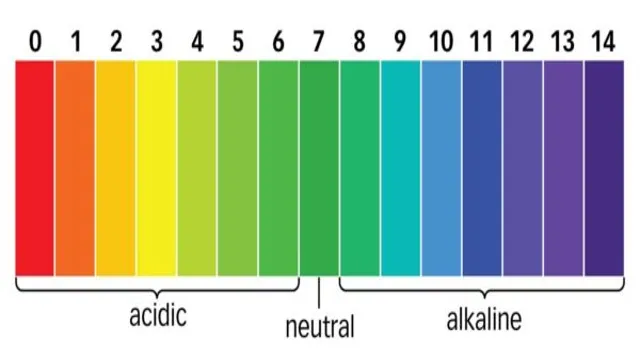Maintaining a healthy and stable pH level is essential for the longevity and overall well-being of aquarium fish and plants. But how often should you test your aquarium pH? Well, the frequency of testing typically depends on various factors, including the size of your aquarium, the number of fish and plants, and the type of filtration system you use. Generally, it’s recommended to test your aquarium pH at least once a week, especially if you’re new to the hobby.
This will give you an idea of how the pH level fluctuates and whether any adjustments need to be made. However, if your aquarium is heavily stocked or has a higher bio-load, it’s advisable to test the pH level twice a week. Waiting too long between tests can cause drastic changes in pH levels, which can be detrimental to your aquatic friends.
On the other hand, testing too frequently could disturb the tank’s natural rhythm and cause unnecessary stress to the fish. Hence, it’s crucial to strike a balance between frequency and consistency. To ensure accurate readings, be sure to test your aquarium pH in the same spot and at the same time of day.
Consider using a high-quality pH testing kit and follow the instructions meticulously. Remember, maintaining a stable pH level is crucial for your aquarium’s health, so don’t hesitate to test your water regularly.
What is pH and Why is it Important?
When it comes to caring for your aquarium, it’s important to understand what pH is and why it’s so crucial. pH measures the acidity or alkalinity of the water in your tank, and it can have a significant impact on the health of your fish and other aquatic life. pH levels outside of the optimal range can lead to stress, disease, and even death in your aquatic pets.
It’s important to test your aquarium’s pH regularly to ensure it stays within the appropriate range, which is typically between 5 and
How often you should test your aquarium’s pH depends on a variety of factors, including the size of your tank, the type of fish and plants in it, and any significant water changes that have occurred. As a general rule, it’s a good idea to test your pH at least once a week, but you may need to test more frequently if you notice any issues with your aquatic ecosystem. By regularly testing your aquarium’s pH and making any necessary adjustments, you’ll help ensure that your aquatic pets thrive and flourish.
Definition of pH
pH pH, or potential of hydrogen, is a measure of the acidity or alkalinity of a solution. It is measured on a logarithmic scale from 0 to 14, with 7 being neutral, and values below 7 indicating acidity and above 7 indicating alkalinity. pH plays a crucial role in a variety of biological and environmental processes, ranging from the acidity of stomach acid to the balance of ecosystems in water bodies.
This is why measuring pH levels accurately is essential in industries such as agriculture, healthcare, and manufacturing. Maintaining a balanced pH level is also essential for the human body to function properly, as our blood and other bodily fluids have a specific pH range that must be maintained for optimal health. In short, understanding and monitoring pH levels is vital for ensuring the effectiveness and balance of biological and chemical processes.

Significance of pH in Aquariums
pH in aquariums, importance of pH in aquariums pH stands for “potential of hydrogen” and it is a measure of the acidity or alkalinity of a solution. In aquariums, pH is important because it affects the health and well-being of aquatic species. Every aquatic organism has a specific pH range in which they thrive, and if the pH in the aquarium is outside of that range, their health can suffer.
For example, if the pH is too low, it can become acidic and harm the fish or plants, while if it is too high, it can become alkaline and negatively impact the dissolved oxygen levels. Therefore, it’s essential to maintain a stable pH range in aquariums to ensure the health and longevity of aquatic life.
Factors Affecting pH Levels in Aquariums
When it comes to maintaining a healthy aquarium, pH levels are a crucial factor to consider. pH levels can be affected by many factors such as the water source, the type of fish and plants in the aquarium, and the type of substrate used. It is recommended to test aquarium pH levels at least once a week, but this can vary depending on the size of the tank and the specific needs of the fish and plants.
A sudden change in pH levels can be stressful for fish and may even lead to health problems or death. In order to keep pH levels stable, it’s important to monitor the levels regularly, perform regular water changes, and avoid overfeeding. Additionally, keeping a variety of plants in the aquarium can help regulate pH levels by producing oxygen and consuming carbon dioxide.
Overall, taking the time to test and maintain proper pH levels can lead to healthier and happier fish in your aquarium. So, how often to test aquarium pH? Let’s say, ideally, at least once a week is best.
Water Source
Water Source The pH level in aquariums is a critical factor that affects the health and well-being of your aquatic pets. Several factors impact the pH levels, and one of the most significant is the water source. The source of your water can determine the initial pH level, which can either be too acidic or too alkaline. (See Also: How to Make Your Aquarium Fish Grow Faster With These Simple Tips)
If the water source is from a well, it may contain minerals like carbonates, which can increase the alkalinity of the water. On the other hand, water from a municipal supply may be treated with chlorine and chloramine, which can affect the pH levels. It’s important to test the pH level of your water source before adding it to your aquarium.
If the pH is too far from the optimal range for your aquarium inhabitants, you’ll need to adjust it using chemicals or other methods to ensure the best possible environment for your pets.
Fish and Plant Species
Fish and plant species One of the biggest factors that affect pH levels in aquariums is the type of fish and plant species that inhabit the tank. Different species have different preferences when it comes to the acidity or alkalinity of the water, which can either raise or lower the pH level. For example, some fish require a more alkaline environment, while others prefer a more acidic one.
The same goes for plants, which can also affect the pH level by consuming or producing carbon dioxide through photosynthesis. To maintain a healthy pH balance, it is important to research the specific needs of the fish and plants in your aquarium and adjust the pH level accordingly. This can be done through regular water testing and the use of pH-adjusting products.
Keeping a balanced pH level not only ensures the health and wellbeing of your aquarium inhabitants, but it also helps to prevent the growth of harmful bacteria that can cause illness or disease.
Aquarium Decor
Aquarium decor When it comes to maintaining a healthy aquarium, pH levels play a crucial role in ensuring the well-being of fish and other inhabitants. A variety of factors can affect pH levels in your aquarium, including the type of substrate used, the hardness of the water, and the types of plants and decorations present. Substrates such as limestone or dolomite rocks can raise pH levels, while driftwood or peat moss can lower them.
Hard water, which contains high levels of minerals like calcium and magnesium, can also contribute to higher pH levels. Meanwhile, plants and decorations such as clay pots or coral can affect pH levels by leaching chemicals into the water. Regular water testing and monitoring can help you spot changes in pH levels before they become problematic, and you can adjust your decor and water chemistry as needed to maintain a stable and healthy environment for your aquatic pets.
Biological Filtration System
One of the most important factors in maintaining a healthy, balanced aquarium ecosystem is the pH level. The pH scale measures the level of acidity or alkalinity in the water, with neutral being 0.
Most freshwater fish and plants thrive in a pH range of 0 to 0, but different species have different preferences.
Factors that can affect the pH level in aquariums include the type of substrate, the presence of rocks or other decorations, the quality of the water source, and the addition of chemicals or other substances. It’s important to monitor the pH level regularly and make adjustments as needed to keep the environment stable and healthy for your aquatic inhabitants. An effective way of maintaining pH level is through biological filtration systems that can create a natural balance and reduce any fluctuations.
By using a biological filtration system, the pH can also stabilize the nitrate levels in the aquarium, which can help to keep the environment as stable and healthy as possible. In conclusion, always ensure to maintain the right pH levels for your aquarium to keep your fish and plants healthy and happy.
Recommended Frequency of Testing Aquarium pH
As pet owners, we want to ensure that our aquariums maintain the optimal pH level so that our aquatic friends can thrive. It is recommended to test the aquarium pH level at least once a week, and more frequently if there are noticeable changes in the tank. Factors such as water changes, new additions to the tank, and medication can all affect the pH level.
Monitoring and maintaining a stable pH level helps prevent stress and disease in our aquatic pets. Testing the pH level frequently also allows for timely adjustments to the water chemistry if needed. Overall, it is crucial to test the pH level regularly to ensure the well-being of our aquatic friends.
So, make sure to stay on top of testing your aquarium pH level, and your aquatic pets will thank you for it. (See Also: How to Activate Aquarium Arch in 5 Easy Steps for Stunning Aquatic Décor)
New Aquariums
Aquarium, pH, testing frequency If you’re a new aquarium owner, you might be wondering how often you should test your aquarium’s pH. The answer depends on a few different factors, such as the type of fish you have and how heavily stocked your tank is. As a general rule of thumb, however, most experts agree that you should test your pH levels at least once a week, preferably twice a week.
This will help you ensure that your fish are living in a healthy environment and that their needs are being met. Testing your pH regularly can also help you catch problems early, before they become more serious issues. By taking the time to test your aquarium’s pH frequently, you’ll be doing your part to create a happy, healthy home for your fish.
Established Aquariums
As an aquarium owner, it’s important to maintain a healthy environment for your fish and aquatic life. One crucial aspect of this is ensuring that the pH level of your aquarium water is within the appropriate range. For established aquariums, it’s recommended to test the pH level at least once a week.
However, there are certain instances where testing should be done more frequently, such as when adding new fish or plants, or when making changes to the aquarium’s filtration or lighting systems. Maintaining a consistent pH level can help promote the growth and health of your aquatic creatures, while also preventing the growth of harmful bacteria and algae. So, make sure to invest in a reliable pH test kit and check your aquarium regularly to keep your aquatic pets happy and healthy.
Methods for Testing Aquarium pH
When it comes to testing aquarium pH, there are various methods that aquarists can utilize. One of the most important factors is the frequency at which pH testing should be done. Ideally, pH levels should be tested at least once a week for stable aquariums and once a day for newly established tanks.
The simplest method for testing pH involves using testing strips which can accurately measure the range of pH in the aquarium. Another popular method is the use of a drop test kit which provides a more precise measurement of pH levels. It’s important to note that pH can vary throughout the day due to factors like fish waste and lighting, so testing at the same time each day can help provide consistent results.
By regularly testing aquarium pH, aquarists can take proactive steps in maintaining a healthy and stable environment for their aquatic inhabitants.
Test Kits
Testing aquarium pH can be done through various methods, but one commonly used way is by using test kits. These kits usually come in strips or liquids, which contain chemicals that react with the water in the aquarium to determine its acidity level. To use test strips, simply dip them into the water for a few seconds and wait for them to change color.
Then, match the color with the chart provided to determine the pH level. Meanwhile, liquid test kits require a bit more effort as one needs to mix the testing solution with water samples taken from the aquarium. Once the solution turns color, compare it with a chart to get the pH reading.
Test kits are easy to use, affordable, and provide accurate results. It is recommended to test the aquarium pH regularly to ensure that the water condition is suitable for aquatic life.
Electronic pH Meters
Aquarium pH Methods for Testing Aquarium pH can involve several options, including using Electronic pH Meters. These meters are an accurate and convenient way to get a quick readout of your aquarium’s pH level. They work by measuring the voltage difference between a pH-sensitive electrode and a reference electrode, which is calibrated to provide a pH reading.
Electronic pH Meters are easy to use and provide a digital display that shows the exact pH level of your aquarium water. They are especially useful for more experienced aquarists who need to monitor and maintain a stable pH level. It’s essential to check the instructions as they vary between different devices to get an accurate reading.
However, digital meters are known to lose accuracy over time, and regular calibration is necessary to maintain their precision. Overall, using an Electronic pH Meter to test your aquarium’s pH is an efficient and reliable method to keep your fish and plants healthy.
Conclusion
In conclusion, testing your aquarium pH is like monitoring a baking cake. You wouldn’t know if it’s ready by just guessing – you have to keep an eye on it, poke it with a toothpick, and adjust the temperature accordingly. The same goes for your aquarium. (See Also: How to Make a Waterfall in an Aquarium: Step-by-Step Guide for Stunning Aquascapes)
Regular pH tests are necessary to ensure the health and happiness of your aquatic pets. It’s better to catch a pH imbalance early and fix it than to wait for a disaster to strike. So, to put it simply, the frequency of testing your aquarium pH should be as often as your sweet tooth tells you to check on that cake in the oven – often and with caution!”
Importance of Regular pH Testing
Regular pH testing is essential for maintaining a healthy aquarium environment. When the pH levels are off, it can negatively impact the health of your fish and plant life. There are several methods for testing the pH of your aquarium water to ensure it stays in the proper range.
One of the most popular techniques is using pH testing strips. These strips are easy to use and provide you with accurate and reliable results within seconds. Another method is a pH meter, which can be more expensive but is more precise and provides a digital readout.
It’s important to note that pH levels can fluctuate throughout the day, so it’s essential to test at different times to ensure a stable reading. Keeping up with regular pH testing can save you from potential disasters and allow for a healthy and thriving aquarium ecosystem.
FAQs
Why is testing aquarium pH important?
Testing aquarium pH is important because it helps to ensure the health and well-being of your aquarium inhabitants. Fluctuations in pH can stress fish and other organisms, potentially leading to illness or even death.
How often should I test my aquarium pH?
The frequency of pH testing depends on the size of your aquarium, the type of organisms you have, and other factors. As a general rule, it’s recommended to test pH at least once a week for a stable, established aquarium.
What is the ideal pH range for most aquariums?
The ideal pH range for most aquariums is between 6.5 and 7.5. This range is suitable for most freshwater and marine organisms commonly found in home aquariums.
What causes pH fluctuations in aquariums?
pH fluctuations can be caused by a variety of factors, such as biological processes, water changes, and decorations or substrate in the aquarium. It’s important to monitor pH regularly and take steps to correct any fluctuations as necessary.
How can I correct high or low pH in my aquarium?
Correcting high or low pH in your aquarium can involve adjusting the water chemistry or adding products specifically designed to regulate pH. It’s important to follow instructions carefully and make gradual changes to avoid stressing your aquarium inhabitants.
Can a lack of pH testing lead to problems in my aquarium?
Yes, a lack of pH testing can lead to problems in your aquarium, including stress, illness, and potential death of aquarium inhabitants. Regular pH testing is an important part of maintaining a healthy and thriving aquarium.
Do I need to test pH if I have a planted aquarium?
Yes, even in a planted aquarium with live plants, it’s important to test pH regularly. Plants can have an impact on pH, and fluctuations can still affect the health of your aquarium inhabitants.







